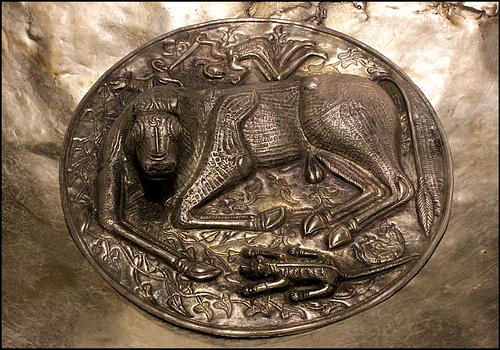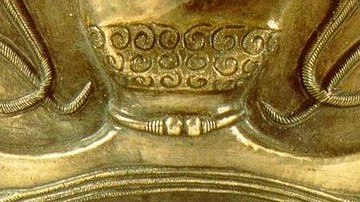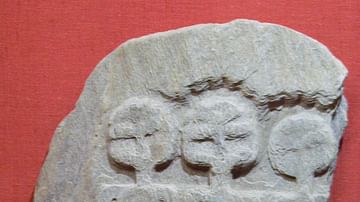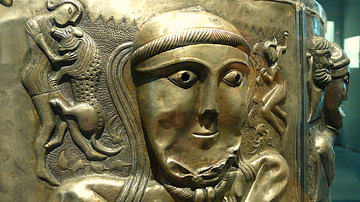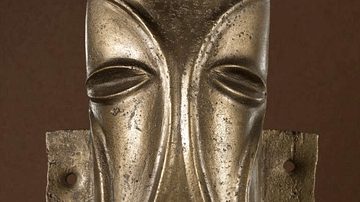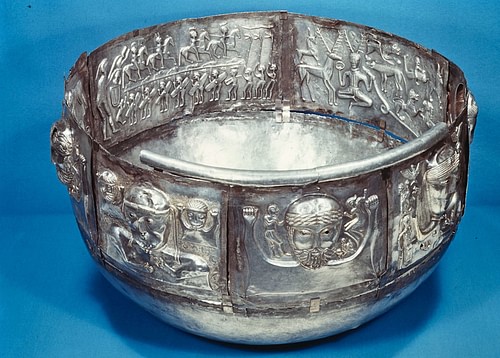
The Gundestrup Cauldron is a gilded silver bowl found in Gundestrup in Denmark in 1891 CE. It was likely made in the Balkans, perhaps in the 1st century BCE, and shows a clear influence from Celtic art and mythology, even if other motifs seem to be Near Eastern. The relief panels on the cauldron show scenes of gods, animals, warriors, and sacrificial rituals, many of which continue to perplex historians as to their precise significance. The cauldron is one of the great examples of ancient European art and is now part of the collection of the National Museum of Denmark, Copenhagen.
Cauldrons in Celtic Culture
The cauldron was an integral part of ancient Celtic feasts and had its own special place in mythology where it was given magical properties and associated with abundance, regeneration, and fertility. The warrior-god the Dagda had the most famous cauldron in the Celtic world, and it was regarded as one of the four treasures of the Tuatha Dé Danann, the pre-Christian Irish gods or supernatural race known as the Tuatha Dé Danann who brought elements of civilization in the Irish Mythological Cycle. The Dagda’s cauldron was special because it was inexhaustible and could feed any number of his followers.
The historian B. Cunliffe here summarises the use of more ordinary cauldrons at Celtic feasts:
The focus of the feast would have been the communal cauldron made of bronze sheets riveted together, with the rim straightened to take two large rings to which were attached chains or ropes so that the cauldron could be suspended over the fire from the roof timbers. To remove the joints of meat from the stew bronze flesh hooks were used.
(68-9)
In addition to their function as a vessel for cooking, cauldrons could be highly decorative and used to display the wealth of the host. There is no better surviving example of this idea than the Gundestrup Cauldron.
Origin & Properties
The Gundestrup Cauldron was discovered by workers cutting peat blocks in a bog near Gundestrup, North Jutland, Denmark on 28 May 1891 CE. The cauldron was one of the greatest ever finds of ancient European art. The details of the decorative reliefs on the cauldron show a clear Celtic influence but some motifs, particularly the exotic animals (lions or leopards, elephants, and griffins), suggest, too, a Near Eastern influence so that scholars generally attribute its manufacture to peoples living in the Lower Danube region, specifically Dacia or Thrace (which is today’s Romania and Bulgaria). The use of silver is another link with the Lower Danube region as it is rare in Celtic art but not so in Thracian art. As the historians J. Farley and F. Hunter note, the cauldron "is not Celtic, or, at least, not just Celtic" (262). As such, it is an object that continues to intrigue all who see it.
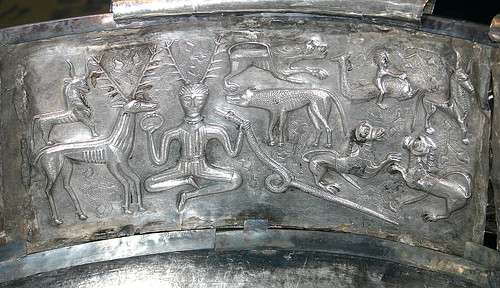
The cauldron likely found its way to Denmark via trade, was given as a gift, or taken there as war booty. Its final destination in a peat bog is probably because it was given as a votive offering, a common practice in the Celtic religion. However, the cauldron had been dismantled into its component parts and had perhaps been transferred to the bog from another burial site. The cauldron has been dated from the period of the 3rd century BCE to the 1st century BCE.
The cauldron is 35.5 cm (14 in) high and 69 cm (27 in) in diameter. It can hold 107 litres (28.5 gallons). It weighs a little over 9 kilograms (20 lbs). The cauldron is made from silver (96% pure) which was originally gilded in parts. It is formed of a plain basin made from a single sheet of silver. The sides are composed of five inner curved rectangular pieces and eight outer curved square pieces (one is missing). These panels are 21 cm in height (a little over 8 in). The eyes of the figures in the outer panels were originally rendered using glass inserts but are now hollow. The side panels are topped by two tubular sections to form a rounded edge for the cauldron’s rim. All 12 side pieces have high relief decoration creating scenes whose significance is still much debated by scholars.
The Relief Panels
Base Roundel
Although the base of the cauldron is of plain silver, it does have a roundel with a scene shown in relief. The craftsmanship of this panel is considered superior to that of the other panels and so it is likely it was added later. In addition, the base displays some damage and so the roundel may have been made to hide this. The roundel measures 25 cm (9.8 in) in diameter.
The scene shows what appears to be a dead bull, above which is a female figure brandishing a sword. Presumably, then, this is a representation of a ritual sacrifice or hunt. Bulls were powerful totems in Celtic culture and one of the animals sacrificed to the gods. The scene also has three other animals amidst foliage; they are perhaps a lizard and two hunting dogs.
Warrior Panel
One interior side panel shows a double row of warriors, the higher level showing cavalry and the lower infantry. The horse riders wear tunics and helmets typically worn by Celtic warriors - conical and with a crest in the form of an animal or horns. These totems, for example, a representation of a bear, boar, or stag, were regarded as protective and deemed capable of giving the wearer the same positive attributes the animal possessed. The horses wear armour over their rumps. The infantry carries typical Celtic shields of a large oblong form. To the right of the panel stand three warriors blowing war horns and wearing helmets, tunics, and breeches. This instrument, known as the carnyx, has an animal-shaped end piece and was used to create noise and organise troops in battle.
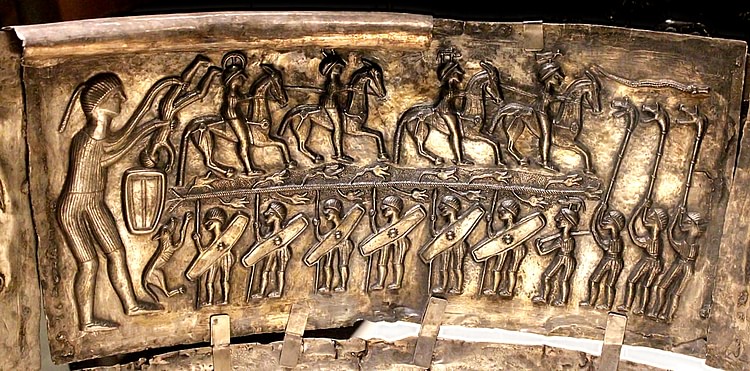
The figure on the left of the scene is more mysterious. Much larger than the warriors, it is likely a god standing next to what seems to be a cauldron. As one of the warriors is dragged into the cauldron by the large figure, perhaps the scene represents the passage into the Otherworld of warriors fallen in battle. Alternatively, the scene may represent the Celtic belief in reincarnation. The infantry march towards the god-figure who dips them in his magic cauldron and so they emerge as higher-status cavalry moving away from the cauldron.
A third interpretation is that the figure represents Teutates, a Celtic god who protected the tribe. Teutates was especially popular in Gaul where Roman writers describe him as receiving sacrificial victims killed by drowning in a tub of water.
Winged-Griffin Panel
This panel shows a male god holding a wheel, a device often representative of the sun in Celtic art. A helmeted warrior is also holding this wheel. Either side is a leopard and below are three winged-griffins (lions with bird’s heads) and a snake with ram’s horns.
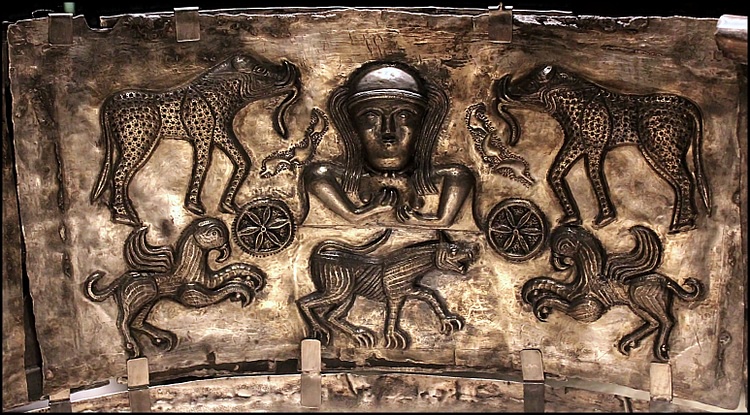
Goddess Panel
In this panel, a female goddess with a wheel on either side of her may be Medb, a major Celtic goddess of territory, fertility, and rulership. The figure wears some kind of helmet and is surrounded by exotic creatures which seem to be elephants, winged griffins, and a large feline. On either side of Medb are what seem to be islands, suggestive of some sort of map, but these could represent blood as similar devices appear at the legs of the bulls in the next panel.
Bull Panel
The fourth interior panel shows a scene with three warriors who are about to sacrifice three bulls using their swords. The bulls are much larger than the warriors, suggesting they represent supernatural versions of the animal. The warriors are helped by three hunting dogs at the base while the top part of the scene shows a trio of spotted felines.
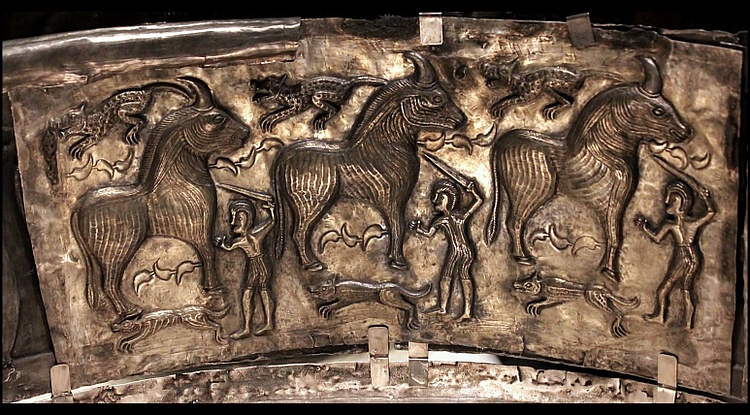
Horned-Figure Panel
A seated god with stag’s antlers is often identified as Cernunnos, an ancient Celtic god who represented nature, flora and fauna, and fertility. Cernunnos is frequently represented in Celtic art wearing horns and wearing a torc, as here. The figure holds an additional torc and a very long snake with a ram’s head, both of which likely signify strength and abundance. There are a stag and deer on the left side and on the right five strange animals and a small figure riding what may be a dolphin.
Outer Panels
The outer panels are square and smaller than the inner ones. Each has the head of a figure holding up their arms or with their arms crossed. Several of these figures are bearded and wear helmets, three are obviously female. Most wear a torc around their neck. Some of the figures hold a human or animal figure in their hands, in others, the additional figures float in the space between the main figure’s raised arms and head. In one panel, the larger deity is flanked by a slightly smaller deity. In all the other panels, the fact that the central figure is much larger than the other figures suggests that they are a god and the peripheral figures are humans. The animals include the real and imaginary, such as dogs, eagles, boars, and winged creatures.
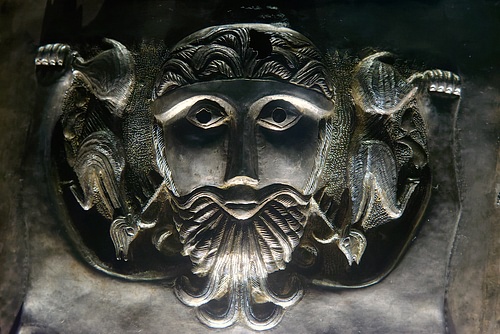
One female deity is having her hair groomed by a diminutive woman. In another scene, a human is wrestling a lion or leopard. In another panel, the small human figures themselves hold an animal and this may indicate a sacrifice made to the god. The significance of many of the other figures and animals is much debated by scholars. As one historian noted, the Gundestrup Cauldron is the ‘Rosetta Stone’ of Celtic mythology but, unlike that Egyptian slab of triple text, the cauldron is yet to be fully deciphered.
